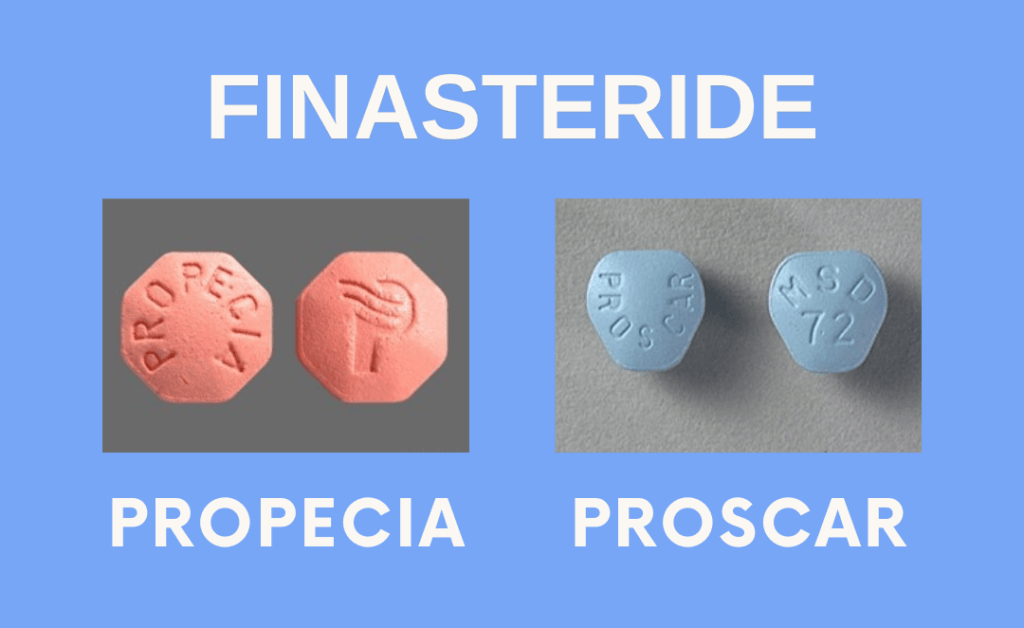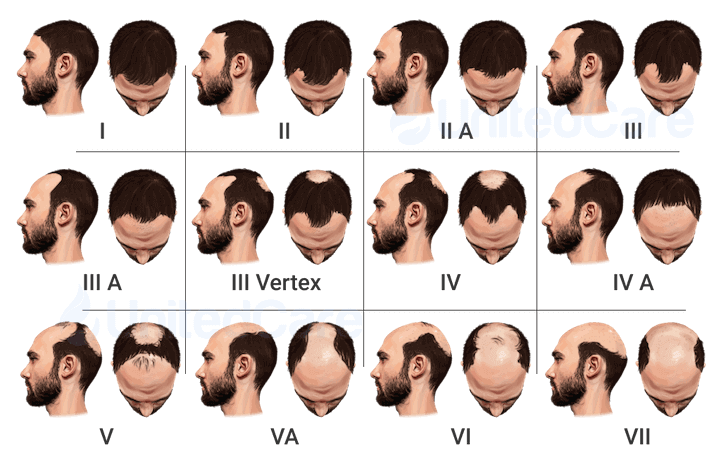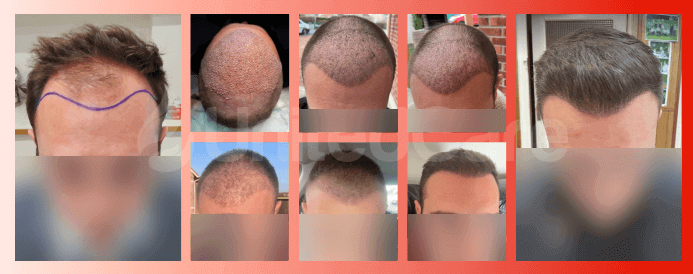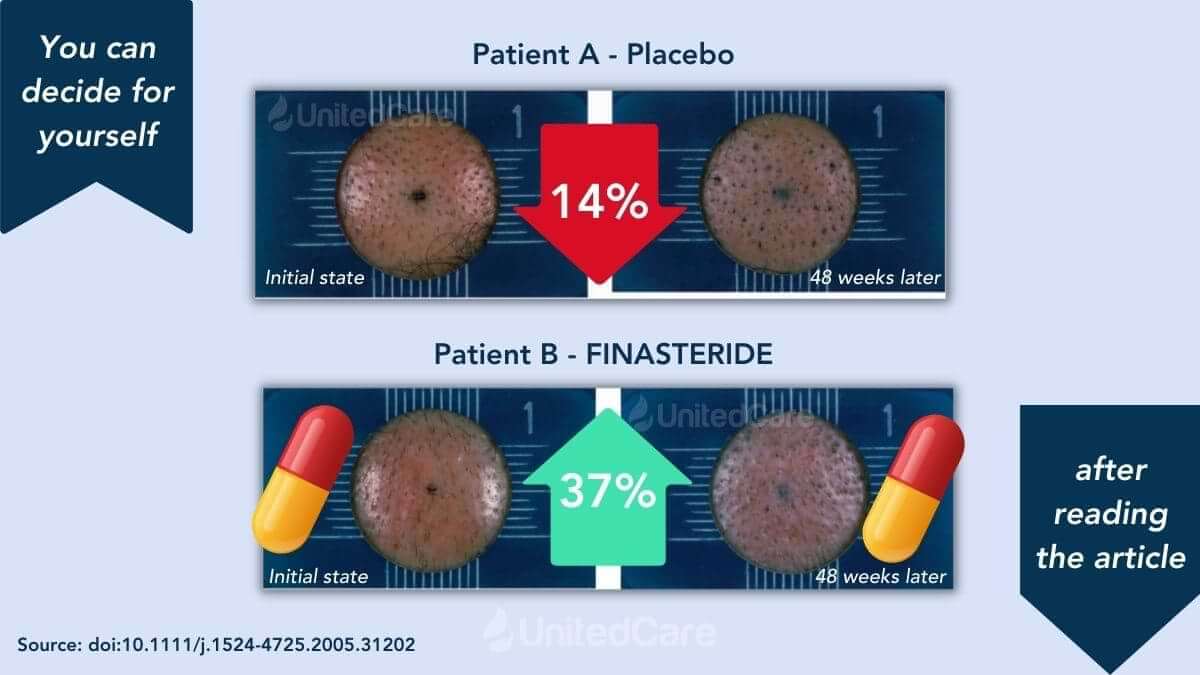TL;DR
➡ Finasteride is a medication used for stopping hair loss that works by inhibiting the production of male pattern baldness hormone dihydrotestosterone (DHT).
➡ Similarly, hair transplants are required when a patient experiences hair loss at such a level that a part of their scalp gets bald. So, new hair is required to be transplanted there.
➡ As hair transplants only resolve a balded area after hair loss has already occurred, they do not guarantee that further hair loss will not happen from other parts of your head.
➡ It is clear that you have to take Finasteride after a hair transplant for better effectiveness and sustainable hair in the long term because the chances of needing a second hair transplant without Finasteride are much higher than any reversible side effects.
So you’re preparing for your surgery soon.
Or you have just decided to get a hair transplant.
Either way, congratulations. Your vision of a new life with great shining hair is just around the corner, but how do you ensure that vision sticks around?
Hair transplant failures or experiencing further hair loss turning in other parts of your head without a transplant are real possibilities. But what if I told you that a future where you never have to worry about balding again exists?
It is very much possible to improve the result of your hair transplant, increase your hair density, and slow down or even completely prevent hair loss on other parts of your head by simply taking a pill of Finasteride every morning.
In the case of Finasteride, I know that taking a pill to prevent baldness worries you. After all, it is a drug that affects your entire body, not only your head. But that’s why I am here, to resolve these concerns, so before we delve into why I recommend that you take Finasteride after a hair transplant, I want you to ask yourself this:
If you were to choose between two, which one would you rather have in your hand every morning, a pill or a lock of hair that has just fallen out of your head?
In this article, I will go through certain aspects of Finasteride so that we can get a clear answer to this question:
Table of Contents
Let’s start by understanding what exactly Finasteride is:
What is Finasteride? 💊
Finasteride is one of the popular FDA-approved supplement medications used in treating male pattern baldness. It is an oral medication you can easily get with your doctor’s prescription and use every morning, making it a topical drug for post-surgery.
When doctors refer to Finasteride, they mainly refer to Propecia.
However, that is not the only Finasteride brand:
There are two Finasteride brands that are as reliable as they are common.

Propecia is the brand name of the drug that contains Finasteride. It is one of the popular versions of Finasteride medications as the active ingredient (Finasteride) responsible for preventing hair loss is also used in other brands.
One other noteworthy example is Proscar. But although Proscar also contains Finasteride, its dosage is much higher than Propecia, 5 mg compared to 1 mg. Due to its high dose, Proscar is mainly used to treat benign prostatic hyperplasia (BPH) patients.
With its different brands and uses, it is clear that Finasteride is a popular drug for hair loss patients.
But important thing to know is that this popularity comes from its success in increasing a hair transplant’s effectiveness:
Do you have to take Finasteride after a hair transplant?
The short answer is yes.
As a doctor who has treated more than 50.000 patients with varying hair loss cases in my career, I can say that after a hair transplant, your biggest guarantee not to experience any further hair loss is Finasteride.
Let me explain how it manages to do that:
How does Finasteride help?

The keyword for understanding why you should take Finasteride after a hair transplant is “progressive.” It is essential to know that hair loss is progressive as this progress will continue to exist without an inhibitor to cut down this process. And here, Finasteride comes in to help.
The primary reason for hair loss in any patient with male pattern baldness is a hormone called dihydrotestosterone (DHT). This hormone makes your hair thinner and causes it to fall out. So, to prevent hair loss, a supplement drug must inhibit this hormone.
Finasteride does precisely that because Finasteride is what is known as a 5α-reductase inhibitor, also known as a dihydrotestosterone blocker. Taking its name from this process, Finasteride inhibits the production of DHT, and as a result, your native hairs do not get thinner and fall any longer.
This step-by-step process, in conclusion, is how Finasteride saves your existing hair from balding. But, Finasteride is not a drug that you can use only once, and to keep its effect, you must continue using it daily. As supported by a study, we advise every patient to continue using Finasteride until a year after the surgery since it improves the results and dramatically boosts hair density and counts. So, ideally, with your doctor’s prescription, you can continue using Finasteride for the long term to maintain its benefits.
But using Finasteride for such a long time can demotivate many patients. So, what we can do here is to show you that the time you will spend with Finasteride will not be unsafe:
✅ To benefit from Finasteride, you will need to take doses of only 1 mg every morning on an empty stomach. This dose is specifically concluded by various research to minimize any unwanted side effects. So, your body will only be taking the minimum and ideal amount of treatment to prevent further hair loss and reduce the potential failure of your hair transplant.
✅ Dozens of experts and studies suggest using Finasteride for long periods. Because combined with its benefits and controllable rare side effects, this option is more reliable in the long term than stopping or not using it all.
✅ The side effects of Finasteride are mild, rare, and completely reversible. Research indicates that the reason these side effects appear is usually connected to an external source such as a secondary disease. So, in that case, you have the option to inform your doctor and decide not to use the medication.
✅ Suppose you experience a severe side effect without a second disease. In that case, you are free to inform your doctor that you will stop using Finasteride as doing so completely resolves its side effects. So, in short, you have the option to stop the process any time you want.
If you are still hesitant about using Finasteride for a long time, we can check on what alternatives you have.
💡 If you are considering mixing Finasteride’s effectiveness with a hair transplant, then you will have time to decide on this subject. Because for the post-surgery process, Finasteride is safe to use 1 month after the transplant.
You can try using Finasteride for a year or at least for the amount of time that your doctor prescribes but stop whenever you wish to stop and leave without any permanent damage. As I have mentioned, Finasteride’s effects are mild, rare, and reversible.
To find a middle ground for our hesitant patients, we recommend that you at least give it a year to gain and see Finasteride’s benefits on your hair, and then decide with your doctor on whether to continue using it. Remember, all the positive effects will vanish when you stop using it. And we recommend getting those benefits to avoid getting further surgeries in the future.
As another alternative, of course, you might wonder if you can have hair transplantation without any Finasteride to support the post-surgery process afterward.
The answer is, sure, you can, but at what cost?
What happens if you don’t?
Your existing hair on the other parts of your head will likely fall out as a hair transplant does not protect the rest of your hair.
Your newly transplanted hair is undoubtedly safe, but the rest is not.
So, as new parts in your scalp will start balding, you will most likely have to get another hair transplant. Some patients may view this as a viable option, but when compared, we see that this is not the best or even a reliable option in the long run. There are numerous reasons for this:
1️⃣ Your head only has a limited number of follicles.
2️⃣ It is much more expensive to get multiple surgeries over and over instead of just using Finasteride of 1 mg daily
3️⃣ It is very mentally damaging to go through surgery only to discover that you must experience the whole procedure again. But, Finasteride’s mental effects are rare and completely reversible if you stop using it.
4️⃣ Finasteride is completely controllable! If you feel the rare side effects have continued for a long time, you can stop using whenever you feel like it. On the other hand, there is no telling how much longer your balding will advance on other parts of your head.
Essentially, this alternative can be seen as the “just get another surgery for the rest of your life or until you ran out of follicles” option, which we find detrimental to our patient’s follicle numbers and their psychological health.
All in all, even without comparing it to the alternatives, we find Finasteride to be more reliable.
Because as studies suggest, Finasteride’s benefits heavily outweigh its rare and easily reversible side effects:
What do experts and studies suggest? 🩺

Finasteride may not be mandatory, but the most reliable option for keeping that best version of your hair with you for a long time is through Finasteride.
But you don’t have to take our word for it solely. Let’s look at some conducted studies over the years to see how effective Finasteride is at preventing hair loss:
A 24-month study made on 1879 patients
▶ In 1999, Dr. K. J. McClellan and Dr. A. Markham conducted a clinical study on 1879 patients with male pattern baldness to test the effectiveness of Finasteride on hair loss.
▶ Patients have taken 1 mg of Finasteride a day orally.
▶ 48% of patients who used Finasteride for one year and 66% of patients who used it for two years showed a significant increase in hair growth.
▶ 83% of patients showed no signs of further hair loss compared with baseline after two years.
▶ Overall, 7.7% of Finasteride patients reported mild to moderate treatment-related adverse events.
💡 Researchers Dr. K. J. McClellan and Dr. A. Markham stated in their research that:
“Oral Finasteride promotes scalp hair growth and prevents further hair loss in a significant proportion of men with male pattern hair loss.”
A 48-weeks study made on 79 random patients over the globe
▶ In 2005, a group of dermatologists, with the lead of famous Dr. Matt Leavitt, conducted one of the most prominent hair transplant studies on the effects of Finasteride.
▶ 79 global patients with androgenetic alopecia (20-45 years of age) were randomly selected and were assigned to treatment with 1 mg of Finasteride.
▶ Visible increases in frontal scalp hair post-transplant were recorded for 94% of patients in the Finasteride. The treatment was generally well tolerated.
▶ Study conducted that to minimize the events of side effects, it is crucial to educate the patients on the matter to remove hesitations and prohibit the placebo effect.
A more recent 48-weeks study made in 2021
▶ In 2021, a group of combined researchers and dermatologists conducted a comparative study with a wide range of male and female patients from different ethnicities and backgrounds.
▶ Study contained different groups of patients that either took 1 mg of Finasteride or 5 mg of Finasteride.
▶ Study is supported by various graphics, demographics, images, and comparisons to earlier studies on this subject.
▶ Especially through (the more recent and modern) comparison of the doses, these clinical trials have proven that the efficacy of oral Finasteride significantly reverses the progression of hair loss in men.
Ultimately, all our literature with different measurements from different years clearly indicates that Finasteride is vital in post-surgery.
And after proper consultation, it is mostly definite that your chosen clinic will suggest for your hair’s long-term health…
…which brings us to finding the right clinic to rely on:
Our approach to hair transplants includes both.

Here at UnitedCare, the success of a hair transplant is our priority.
We want to ensure that you get the perfect result, and more importantly, we want to ensure you never have to worry about balding again. Therefore, we suggest Finasteride, as well as other supplements, for the post-surgery process.
Our process for helping you achieve your best self includes getting you the hair of your vision and ensuring that transplanted hair stays alongside your existing ones.
Researching a drug from scratch and deciding on using it or not can be a complicated process, and besides, using a prescription with so many concerns is unsafe. So, just as the studies indicate, we believe in the importance of educating and helping our patients before and after the surgery is already done:
1️⃣ Our approach begins with consulting you on every question you have so that we can give you the best solution you want without hesitation.
2️⃣ Then, we move on to using medications such as Finasteride and doing hair massage, herbal therapy, and exercise to reduce your hair loss to a minimum before the surgery.
3️⃣ Lastly, after the surgery, we will stay beside you for further communication on properly using Finasteride and knowing what to do in case of any side effects or questions you may have. As research indicates, using oral Finasteride until at least a year after the surgery will significantly improve the result of your hair restoration process.
Afterward, we will still be only a phone call away from you, and if you’re pleased with the results, we will prescribe you to continue using Finasteride. If not, you are free to stop using it.
Balancing your health and comfort matters, and we will achieve it.
Ready to begin the journey? Click here to start the first step:
Ensure the success of your hair transplantation with Finasteride.
UnitedCare‘s expert dermatologists provide you with a holistic approach to hair transplants and Finasteride:
Frequently Asked Questions (FAQs)
Can you get a hair transplant without Finasteride?
You technically can, but not without any downsides. The most prominent one is leaving yourself defenseless against the progression of hair loss. Without any supplement drug such as Finasteride, you will be susceptible to keep losing hair, and it will most likely lead to further surgeries down the road. Remember, only a limited number of grafts are in your head to continue the process. Finasteride, on the other hand, is a definite solution.
How does Finasteride help with hair transplants?
Finasteride ensures two things. It significantly improves the results of hair transplant surgeries, boosts hair density, and increases hair counts. Secondarily but more importantly, it also protects the rest of your hair that did not get a hair transplant. A newly transplanted hair is permanently protected from DHT and, therefore, hair loss, but the rest of your hair is not. Finasteride comes into play in this case as it inhibits the hormone DHT from producing, which protects your native hair from getting bald.
How long should you use Finasteride after the surgery?
Ideally, it is advised to continue losing Finasteride until a year after the surgery. Various research has proven that this process is vital in supporting the newly transplanted hair post-surgery and preventing further hair loss. However, numerous patients keep using Finasteride even longer than a year with their doctor’s supervision as its benefits are too great to ignore. If you wish to continue benefiting from Finasteride, you must be ready to continually use it for the long term as it is not a one-time drug, and its effect will vanish if you stop using it.

